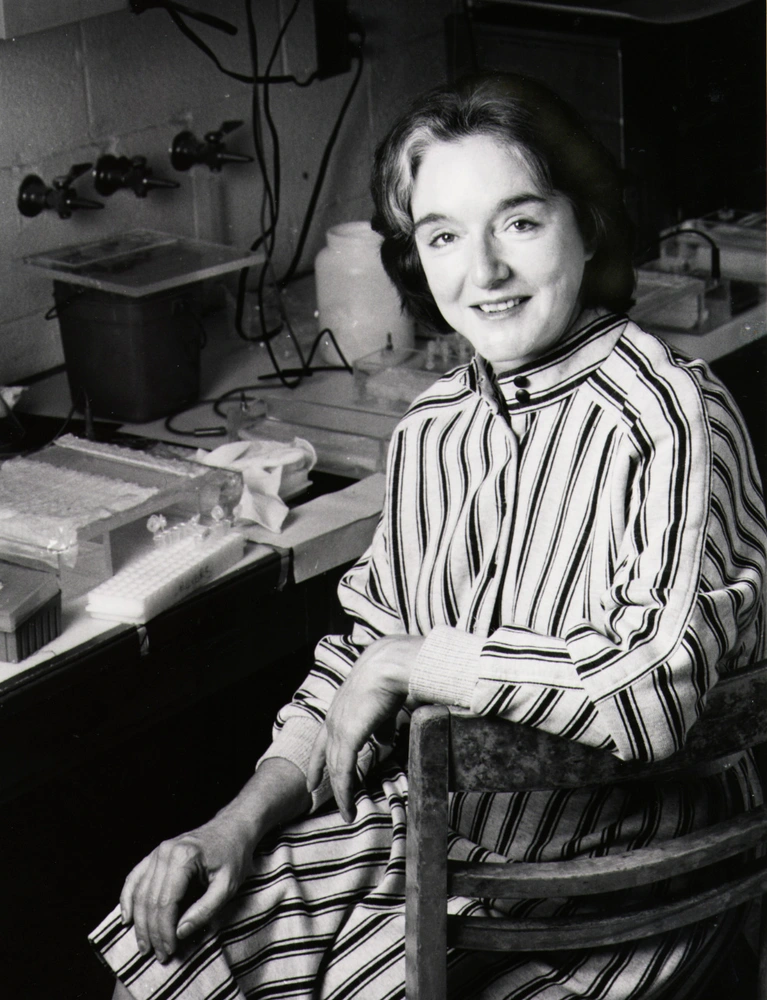
During her 40-year career, Abigail Salyers revolutionized how we think about the bacteria that live in the human intestinal tract, helped design antibiotic drugs, and provided a voice of reason in discussions on bioterrorism, transgenic plant safety, antibiotic resistance in medicine and agriculture, and more.
The former Arends Professor Emerita of Microbiology is remembered for her intellect, sense of humor, and exceptional ability to teach and mentor others as a professor, graduate advisor, and fellow human being.
Teacher
“I try to help to prepare the students as well as I can to go forward in the sciences as well as to communicate with the public,” Salyers said on a “Meet the Scientist” podcast with Merry Buckley. “I think that’s a very important thing that we tend to undervalue in our graduate teaching. But I also try to motivate them to not just want to go out and try to get a well-paying job, but also to really love science and be excited about it.”
Salyers also talked about helping her students cope with failed experiments, an inevitable part of any successful research career. “It’s going to be up and down like that for the foreseeable future, so you have to learn to relax into it and go with the various currents—bob like a little cork on the stormy sea,” Salyers said.
She was also a mentor to her colleagues, including faculty at the Institute for Genomic Biology (IGB), where she was a member in the Biocomplexity (BCXT) research theme.
"Abigail was an active and strong supporter of the BCXT theme when we started to develop our research agenda, and was a kind and willing mentor to those of us who were neophytes in microbiology,” said Nigel Goldenfeld, Swanlund Professor of Physics and leader of the BCXT research theme. “Perhaps she remembered how it was for her when she transitioned from nuclear physics into microbiology many years ago. She was one of the earliest to emphasize the role of horizontal gene transfer in evolutionary ecology, and also was one of the first to emphasize the view that the body is a microbial ecosystem."
Researcher
Salyers earned a bachelor’s degree in mathematics in 1963 as well as a doctorate in physics in 1969 from George Washington University. For four years, she taught physics at St. Mary’s College as an assistant and associate professor, but she recognized that she would need to change her field of study in order to achieve her career goals.
“At the time, a lot of people had been recruited into physics, and then the bottom dropped out of the job market,” Salyers told Pam Das in a 2003 interview for THE LANCET. “I was employed as a professor at a small state institution, and I had to make a choice, whether to stay in physics or stay in research, so I decided to leave physics. My walk into microbiology was largely a random one.”
In 1973, she took a visiting professor position at the Virginia Polytechnic Institute where she studied the metabolic activities of anaerobes. She joined the University of Illinois in 1978, became the first female tenured professor in microbiology at Illinois in 1983, and a full professor in 1988. In 2004, she was awarded the G. William Arends endowed appointment for her achievements in the field.
“We are a microbial planet. Given this, it is surprising that we really know very little about what those microbes are doing to and for us,” Salyers told Das. “Clearly they had a major role in human evolution, in the design of the human body. Just look at the structure of the intestinal tract, which is basically designed to be a holding tank for bacteria.”
She was intrigued with the duality of our colonic bacteria.
“Our colonic bacteria allow us to have a second chance at digesting the fibrous materials in our diet that our own cells cannot digest,” Salyers said to Das. “Yet these bacteria, if they escape from the intestine, can kill us. After all, intestinal bacteria are a major cause of postsurgical infections, and can also cause opportunistic infections in patients undergoing cancer chemotherapy. So our relationship with our bacteria is a mixed one.”
Throughout her microbiology career, she studied the interaction of these colonic bacteria with their host, antibiotic-resistance gene transfer, genetics of obligate anaerobes, and conjugative transposons of Bacteroides. She published more than 150 scientific papers and two textbooks.
While at Illinois, Abigail was named a University Scholar, Faculty Member of the Year in the College of Medicine, and a member of the Center for Advanced Study. She also received an Award for Excellence in Teaching from the University of Illinois at Chicago.
Giver
During the anthrax episodes in 2001, Salyers served as president of the American Society for Microbiology, the oldest and largest single life science membership organization in the world. She took it upon herself to educate local postal workers about the dangerous bacterium.
When others believed more research should be devoted to studying anthrax and other bioterrorist agents, Salyers remained cognizant of the “most successful and dangerous of all bioterrorists”—Mother Nature. She stressed the need for more research on influenza, hospital-acquired bacterial infections, and other diseases that threaten thousands of lives each year.
Throughout her career, Salyers was dedicated to public outreach and education and numerous service roles. She was president of the board for El Centro (a center that assists local Latino migrant workers), reviewed grants for the National Institutes for Health, and provided expert testimony on transgenic plants and antibiotic use in agriculture for regulatory agencies in Europe and the U.S.
“Abigail was an eminent scientist and a wonderful colleague, and we'll miss her,” said Gene Robinson, Director of the IGB.
Salyers died on November 6, 2013 at the age of 70.